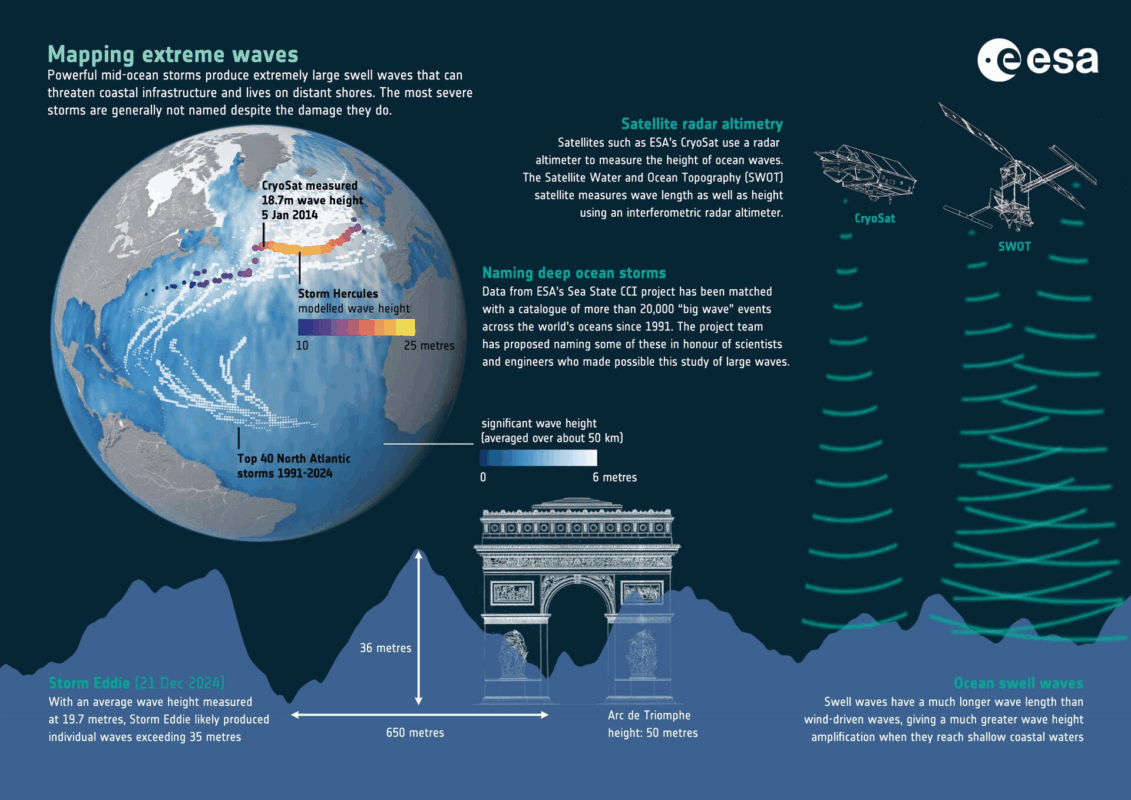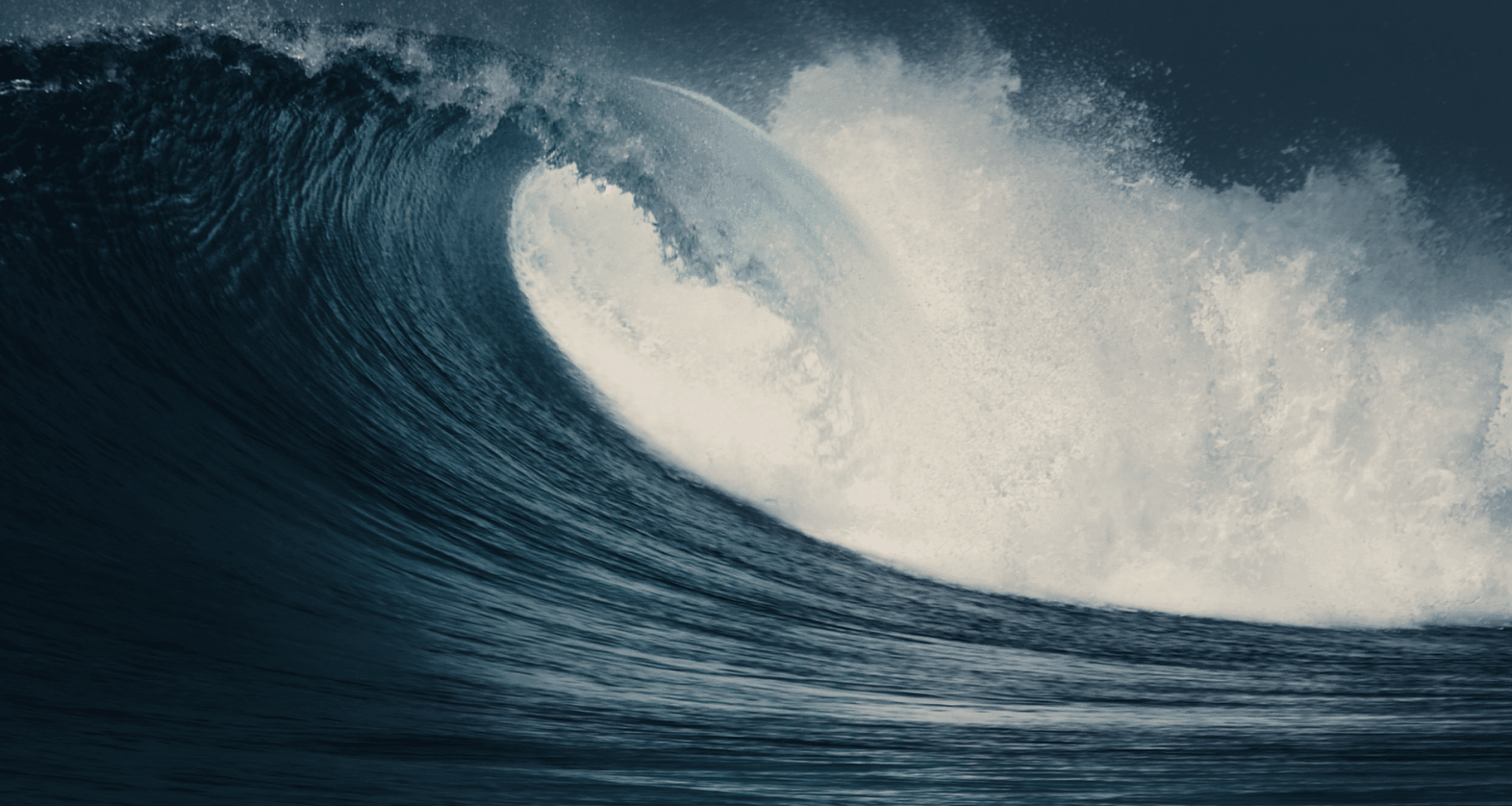In December 2024, a colossal Pacific storm unleashed waves of unprecedented magnitude, visible even from space. These towering swells not only shattered records but also had a profound impact on both science and surfing culture. By utilizing cutting-edge satellite technology, scientists from the European Space Agency (ESA) were able to measure these massive waves. The findings, published in the journal PNAS, offer new insights into how ocean energy travels across vast distances.
The Power of Monster Waves: A Record-Shattering Event
The storm, which occurred in December 2024, was a powerful reminder of nature’s raw force. Satellite observations revealed oceanic waves that reached heights never seen before, with some waves surpassing 115 feet. The massive swell, identified as Storm Eddie, was tracked by the European Space Agency’s Surface Water and Ocean Topography (SWOT) satellite. The findings highlighted that the storm’s waves were not only the largest ever recorded by space-based instruments but also traveled extraordinary distances across the globe.
One of the most striking features of the storm was its ability to send waves across 15,000 miles of ocean, from the North Pacific to the tropical Atlantic. This data offers new insights into how energy from storms can travel across vast stretches of ocean, impacting regions far from the storm’s original location. For many, these findings are a breakthrough in understanding the behavior of extreme waves and their potential consequences for coastal areas.
The study conducted by Fabrice Ardhuin, a scientist at the Laboratory of Physical and Spatial Oceanography in France, marks a milestone in satellite-based oceanography. The study, recently published in the journal PNAS, underscores the scale of these waves, which were much larger than previous models had predicted. The storm’s powerful impact was felt globally, with its swells reaching far beyond the Pacific, affecting various coastal regions and even contributing to the legendary surfing events at Waimea Bay and California’s Mavericks.
How Satellites Unveiled the Wave Giants
The key to understanding the size and impact of these waves lies in the sophisticated technology that tracked them. ESA’s SWOT satellite played a crucial role in documenting the storm’s waves in real time. Using a combination of radar and altimetry, the satellite captured detailed data about the wave heights, frequencies, and energy, painting a clear picture of the storm’s ferocity.
Interestingly, while the storm itself may have been localized, its waves carried a massive amount of energy that spread across oceans, affecting coastlines thousands of miles away. These findings reveal the power of “long-period swells,” which, although generated far offshore, have the ability to cause destruction on distant shores. The wave period, the time between successive crests, is a key characteristic that helps scientists understand the storm’s intensity and potential impact.
The data from the SWOT satellite also provided valuable insights into how these long-distance swells can serve as messengers of powerful storms. Even when a storm is no longer active, the energy from its waves continues to travel, reshaping coastlines and creating hazards for shipping and coastal infrastructure. This aspect of ocean dynamics has long been of interest to scientists, as it helps in predicting the future behavior of oceanic systems.

The Role of Storm Eddie in Surf Culture
While the scientific community has been closely monitoring these waves, surfers have been riding them for decades. The massive swells generated by Storm Eddie contributed to two of the most iconic surfing events in history: the Eddie Aikau Big Wave Invitational at Waimea Bay in Hawaii and legendary rides at Mavericks in California. These events highlight the intersection between extreme weather phenomena and surf culture, with surfers chasing waves that are almost as awe-inspiring as they are dangerous.
The storm’s waves, towering above 65 feet on average, provided some of the biggest challenges for professional surfers, as they tested their skills against nature’s most formidable creations. However, this connection between massive waves and surfing also emphasizes the need for safety measures and proper preparation. Surfers are often at the forefront of experiencing the power of these waves, but their stories also help scientists understand how these waves behave in real-world conditions.
Recalculating the Energy of Ocean Waves
For years, scientists have understood that ocean waves carry energy, but the new findings from the SWOT satellite challenge previous assumptions about just how much energy is involved. The study, recently published in the journal PNAS, corrected earlier models that underestimated the energy content of extreme storm waves. Previously, it was thought that energy was spread across the longest wavelengths, but the new data shows that the energy is concentrated in the dominant storm waves, making them more destructive.
This revelation is comparable to a boxer delivering a few powerful punches instead of multiple weaker strikes. Understanding how energy is distributed within storm waves will help improve predictions of wave behavior, which is crucial for coastal planning and storm preparedness. With climate change potentially intensifying storm activity, it’s more important than ever to have accurate data on wave behavior to protect vulnerable coastal areas.
Linking Storm Intensity with Climate Change
One of the future directions of this research is exploring the connection between extreme storms and climate change. Dr. Ardhuin and his team plan to investigate whether these massive storms are becoming more frequent or intense due to shifts in global climate patterns. While it’s difficult to establish clear trends due to the rarity of such large storms, the team is leveraging decades of satellite data to model potential long-term changes.
The ongoing challenge is determining how much of this increase in intensity is driven by human-induced climate change, versus natural variability. While large storms like this are rare, their potential to cause destruction is significant. As scientists refine their models and increase their understanding of wave dynamics, we may be better equipped to anticipate and mitigate the impacts of these monstrous waves on coastal communities and infrastructure.

